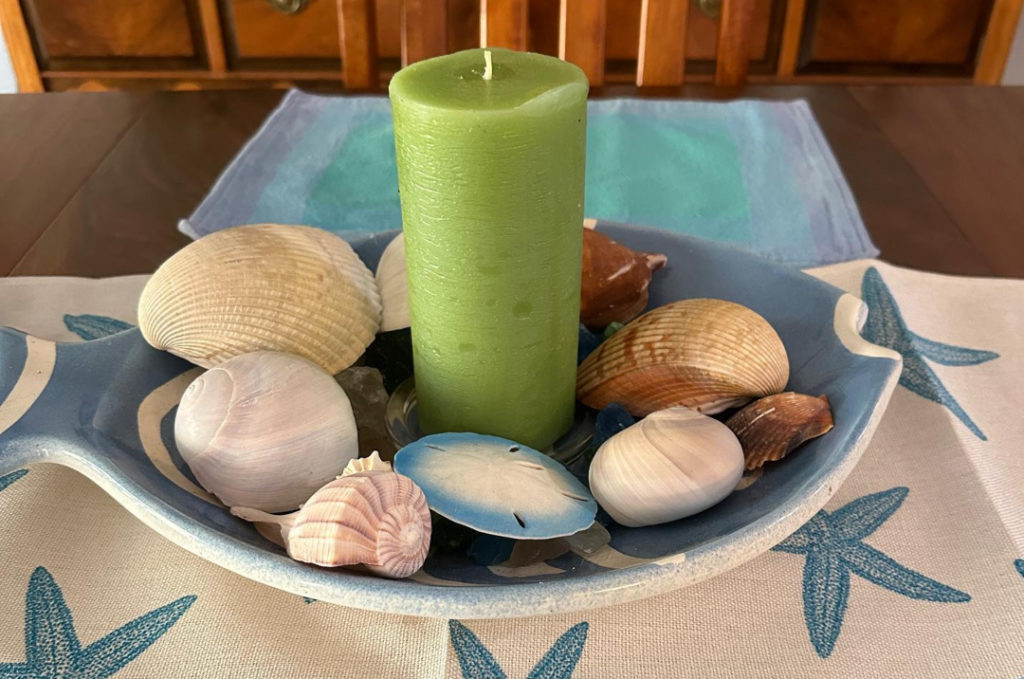I come from a long line of seasonal decorators. I don’t mean professional designers – just women who love to change their household décor with the season. And I do mean every season. I always thought this was just a quirk of my family, but I’ve come to realize that it’s also a great way to stave off the deep-winter blues that settle in after Christmas and before Valentine’s Day. (I think most people just call this “January,” but it’s not strictly limited to the first month of the year.)

It begins with the stripping away of all the holiday trappings, usually on the first day of the year, but sometimes the following weekend. Red and green are packed away to be replaced with calming pastels – tranquil blues and creams – punctuated with bursts of color (turquoise, lime green, orange) that are like visual bubbles of delight. They lack the audacity of Valentine reds, purple, and pink, and aren’t quite as vivid as the colors of spring and summer, but they feel light and positive when compared to the muted light and bare trees outside.
For my grandmother, my mother, and me this freshening of the décor (which even includes changing the quilts and bedsheets to softer, lighter colors) also helps us fight off the inevitable post-holiday let-down. After all, we’ve just completed six weeks of doing far too many things, usually at a break-neck speed. When all that adrenaline is gone, things get a bit murky.
Seasonal Affective Disorder is a real thing, but even for those of us who don’t have any kind of clinical depression, deep winter – January – is a challenge. For caregivers, it’s even more so because we must balance our own moods and reactions with those of the people we support.
If changing the colors of your table and bedroom linens doesn’t work for you, here are some other ideas that you might find useful:
- Get physical. I’m not talking about a resolution to lose twenty pounds or become a marathon runner. Movement of any kind releases endorphins that boost your mood. Since it’s too cold – even in Florida – to kayak right now I’ve been using a stationary bike, stretching at the portable ballet barre I put in my lanai, and pulling my husband or my bigger dog into random moments of dance. If you own a good coat (I don’t any more) and the sidewalks are clear where you live, a daily walk (with or without a furry companion) is a great way to move. For those with mobility issues, chair yoga is a great option.
- Create something. I try to do one creative thing every day, because it stimulates my brain, and makes me happy. So far this month, I’ve re-connected with my writing muse, experimented with new cookie recipes, and planned two costumes for a themed cruise I’m going on next month. I have no talent for visual art (though I do have a love of art supplies) so I don’t draw or paint, but I know a lot of people who do. My grandmother used to love coloring books and colored pencils when she couldn’t do more active things. My Bubbie (Yiddish for grandmother) began piano lessons when she was 76.
- Eat the rainbow. While I try to eat reasonably healthy food all the time, I really love making colorful food in the middle of winter. Last week I made a salad that had craisins (dried cranberries) walnuts, and golden berries (they look like a cherry tomato but have a sort of tart mango-ish flavor), and the colors were so pretty, I almost didn’t want to eat it! Blue potatoes, purple yams, red and gold beets, and multi-colored carrots are just some of the ways to incorporate color into meals, and it can be fun to experiment with new foods and flavors to keep ourselves and those we care for interested and engaged at mealtime.
- Stay social. The holidays are often so jam-packed with company that it’s nice to have a breather when everyone goes home, but after that, it’s important to stay social. Whether it’s exchanging cards, talking on the phone, chatting online, meeting for lunch, or even joining a book club or walking group, connecting with other people is important for our own well-being. For our loved ones who are in care, it’s the visits when it’s NOT the holidays that are often more important.
- Rest. After all the craziness of the holidays, plus the exercise, creativity, and cooking, and socializing mentioned above, it’s important to rest. Whether it’s an afternoon nap, taking time to savor tea or coffee, or curling up with a good book, rest is important. Our minds and bodies need downtime to recover, and spending time with ourselves gives us time to assess: how are things going? What do we want to change?
Deep winter can be more blue than bright. The time from January to spring may seem interminable. As John Steinbeck asks us, “What good is the warmth of summer, without the cold of winter to give it sweetness?”
May your winter be just cold enough to make the coming summer seem sweet.
